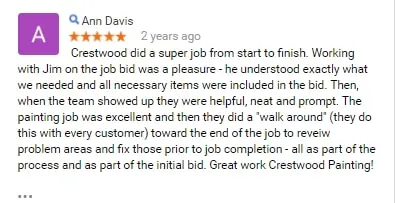Popcorn Ceiling Removal

Popcorn Ceilings Make an Impression
Popcorn ceilings were popular in mid-20th century homes due to their noise-dampening qualities and ability to hide imperfections. Thankfully, they’ve fallen out of favor due to their dated appearance and potential asbestos content.
Bad News / Good News
Popcorn ceilings are not just unattractive—they may also pose health risks due to asbestos, which was commonly used in ceiling textures before the 1980s. The good news? These ceilings can be safely removed, giving your home a cleaner, more contemporary appearance.
If the test sample contains no asbestos we'd be happy to discuss the options!
Asbestos - Test First
Disturbing asbestos-containing materials can release harmful fibers into the air, posing serious health risks. Our insurance carrier won’t let us consider removing popcorn texture until it’s been tested. We recommend reaching out to the nice people at Hernly Environmental in Lawrence for accurate asbestos testing.
Positive Test (Yes Asbestos)
If the asbestos test comes back positive, the safest course of action is to call a licensed asbestos abatement firm. Faced with the complexity and cost of asbestos abatement, many homeowners “reconsider” their need for removal. In these cases, encapsulation or simply leaving the ceiling undisturbed may be the best choice.
Negative Test (All Clear)
Great news — if the test results show no asbestos, you have a range of safe and effective removal options. We can help you decide on the best approach, whether it's scraping, retexturing, or completely refinishing the ceiling. We’ll guide you through the process to achieve a smooth, up to date look that enhances your space.
After popcorn is removed there will likely be damaged or poorly finished corners or joints which should be repaired.
Popcorn Ceiling Details
After popcorn ceiling removal, the underlying surface often reveals flaws, such as damaged corners or poorly finished joints. These imperfections are a result of builder shortcuts (not fully finishing the drywall), knowing the textured ceiling would hide any defects. Crestwood Painting specializes in repairing these areas as well as larger interior painting projects, ensuring a flawless finish. We can patch, sand, and smooth out any rough spots, preparing the ceiling for paint or a new texture.
Ceiling texture was also used on older plaster ceilings as an effective means of covering decades of cracked plaster. Same thing applies: removing the texture will likely uncover some bad news that will have to be dealt with.
Alternatives to Popcorn Ceiling Removal
Options include covering the ceiling with drywall, applying a new texture, or simply painting over it for a fresh look. Discover the pros and cons of each method.
Paint-and-Ignore
This is the easiest and most cost-effective option. First, vacuum to remove dust; then seal any water stains and paint - it’ll be bright and clean.
Retexture - Don’t
Not kidding here. Adding more texture will stress the adhesive bond of the existing texture. Imagine some of your new texture pulling off some of your old texture and falling on your bedspread while you doze. ‘Nuff said.
Drywall to the Rescue
New drywall is securely screwed to the existing ceiling, encapsulating any nasty texture. Thoughtful treatment of edge joints and electrical fixtures means you'll have a ceiling you can finally ignore. 😄
History of Popcorn Ceiling Texture
Popcorn ceilings gained popularity in the 1950s for their noise-dampening and flaw-concealing qualities. They were widely used into the 1980s but later fell out of favor as styles changed. Health concerns over asbestos also contributed to their decline. Today, most homeowners prefer removing them for a cleaner, modern look.
Cost of Popcorn Removal
The cost of popcorn ceiling removal depends on several factors that can affect the cost significantly, including the size of the area, ceiling height, ceiling slope, ceiling access and whether asbestos is present. Generally, removal costs start at about $5 per square foot for non-asbestos ceilings. Crestwood Painting provides detailed estimates, ensuring transparency and no surprises. Our team can guide you through the process, from testing and safe removal to a finally beautifully finished ceiling.
More Info Needed?
Take a look at what many previous customers have said in rave reviews about interior painting and wallpaper removal. Be sure to not miss 12 Questions to Ask before you hire a painter.
